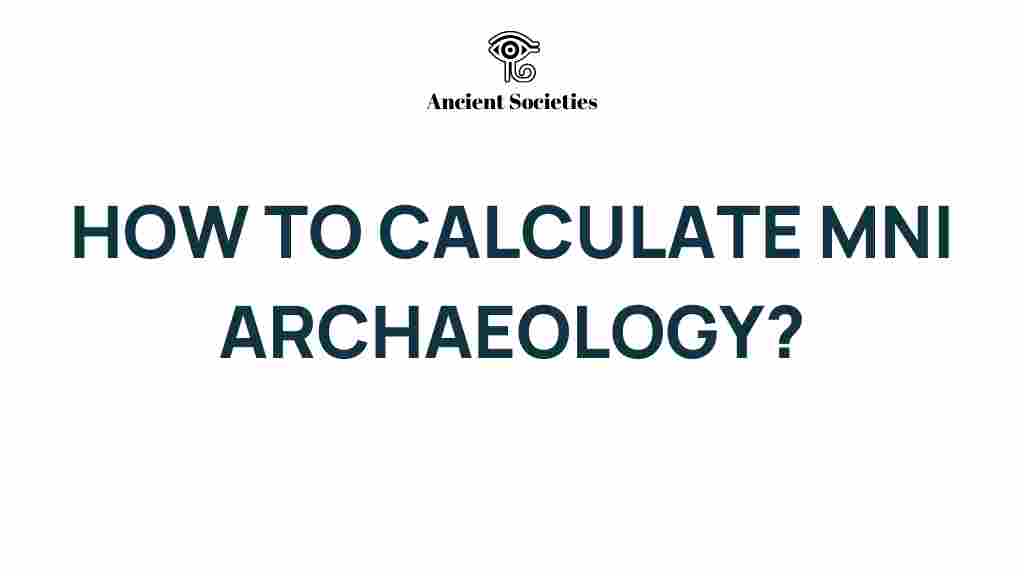Unlocking the Secrets of MNI in Archaeology: A Guide to Calculation
Understanding Minimum Number of Individuals (MNI) is crucial for archaeologists as it provides insights into past human behaviors and population estimations. This article delves deep into the concept of MNI, exploring its significance, calculation methods, and how it aids in the research of artifacts and archaeological sites.
What is MNI?
Minimum Number of Individuals (MNI) refers to the smallest number of individual organisms that could account for the observed remains in a given archaeological context. In archaeology, MNI is often used to estimate the number of people or animals present based on the recovered artifacts. This calculation is vital for understanding demographic patterns, social dynamics, and resource usage among ancient populations.
The Significance of MNI in Archaeology
MNI holds significant importance in various archaeological aspects:
- Population Estimation: MNI helps in estimating the size of past populations, which is essential for understanding human activity and settlement patterns.
- Behavioral Insights: By analyzing MNI, researchers can infer social structures, hunting practices, and dietary choices of ancient peoples.
- Artifact Analysis: MNI aids in the contextualization of artifacts within archaeological sites, linking them to potential human interactions.
Methods of Calculating MNI
Calculating MNI can be approached through various methods, depending on the type of artifacts and remains found. Here are some of the most common calculation methods:
1. Count-Based Method
This is the simplest method, where archaeologists count the number of identifiable specimens of a species. Each unique specimen contributes to the MNI count.
- Example: If an excavation site yields 10 bones from a single species, the MNI could be estimated at 10.
2. Bone Element Method
In this method, different bone elements that can be attributed to individual animals or humans are counted. Certain bones, like skulls or femurs, are more indicative of individual organisms.
- Example: If a site has 4 left femurs and 3 right femurs, the MNI based on femur pairs would be 4.
3. Combinatorial Method
This method involves complex statistical calculations based on the combinations of different elements found. It is used when many fragments of different species are present.
- Example: Archaeologists may apply statistical formulas to estimate MNI by evaluating the overlap of different bone fragments.
4. Statistical Modeling
Advanced statistical models can also be used to estimate MNI by analyzing the distribution of remains and applying probability theories.
- Example: Bayesian models can provide a more nuanced estimation by incorporating uncertainties and variations in the data.
Step-by-Step Process for Calculating MNI
Here’s a structured approach for calculating MNI in archaeological research:
- Step 1: Gather Data – Collect all relevant artifacts and remains from the excavation site.
- Step 2: Identify Specimens – Sort the artifacts into identifiable groups based on species or type.
- Step 3: Choose a Calculation Method – Decide on the most appropriate method for your dataset.
- Step 4: Perform Calculations – Apply the chosen method to calculate MNI.
- Step 5: Record Findings – Document the findings and provide context for your calculations.
Troubleshooting Common Issues in MNI Calculation
While calculating MNI, archaeologists may encounter several challenges:
- Poorly Preserved Remains: Fragmentary or degraded remains can complicate identification. Use comparative analysis with well-preserved specimens to aid identification.
- Overlapping Specimens: When remains from different individuals overlap, it can skew MNI estimates. Always cross-reference with other artifacts.
- Sampling Bias: Ensure that the sample size is representative of the entire site to avoid misleading conclusions.
Real-World Applications of MNI in Archaeology
MNI calculations are applied in various archaeological studies:
- Zooarchaeology: In studies of ancient animal remains, MNI helps determine hunting patterns and animal domestication.
- Human Osteology: MNI assists in the reconstruction of ancient populations and understanding social hierarchies.
- Site Management: Understanding MNI can influence conservation strategies and site management decisions.
The Future of MNI Research in Archaeology
As technology advances, the methods of calculating MNI are likely to evolve. Emerging fields such as bioinformatics and machine learning may enhance our capabilities to analyze large datasets, providing more accurate estimates. Additionally, interdisciplinary approaches that combine archaeology with genetics and ecology could yield richer insights into past populations.
Conclusion
Unlocking the secrets of Minimum Number of Individuals (MNI) is essential for archaeologists striving to understand the complexities of ancient societies. By utilizing various calculation methods and addressing common challenges, researchers can glean valuable information about past populations, their behaviors, and their interactions with the environment. MNI not only aids in population estimation but also significantly contributes to the broader understanding of archaeological contexts.
For more information on archaeological methodologies, consider visiting Archaeological Research Network. Additionally, you can explore further studies on MNI and its applications in archaeology through this external resource.
This article is in the category Archaeology and created by AncientSocieties Team
